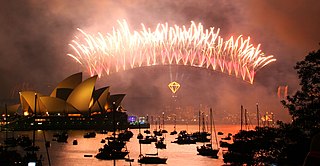
Fireworks are a class of low explosive pyrotechnic devices used for aesthetic and entertainment purposes. They are most commonly used in fireworks displays, combining a large number of devices in an outdoor setting. Such displays are the focal point of many cultural and religious celebrations, though mismanagement could lead to fireworks accidents.

A meteoroid is a small rocky or metallic body in outer space. Meteoroids are distinguished as objects significantly smaller than asteroids, ranging in size from grains to objects up to a meter wide. Objects smaller than meteoroids are classified as micrometeoroids or space dust. Most are fragments from comets or asteroids, whereas others are collision impact debris ejected from bodies such as the Moon or Mars.

A meteor shower is a celestial event in which a number of meteors are observed to radiate, or originate, from one point in the night sky. These meteors are caused by streams of cosmic debris called meteoroids entering Earth's atmosphere at extremely high speeds on parallel trajectories. Most meteors are smaller than a grain of sand, so almost all of them disintegrate and never hit the Earth's surface. Very intense or unusual meteor showers are known as meteor outbursts and meteor storms, which produce at least 1,000 meteors an hour, most notably from the Leonids. The Meteor Data Centre lists over 900 suspected meteor showers of which about 100 are well established. Several organizations point to viewing opportunities on the Internet. NASA maintains a daily map of active meteor showers.

Pyrotechnics is the science and craft of creating such things as fireworks, safety matches, oxygen candles, explosive bolts and other fasteners, parts of automotive airbags, as well as gas-pressure blasting in mining, quarrying, and demolition. This trade relies upon self-contained and self-sustained exothermic chemical reactions to make heat, light, gas, smoke and/or sound. The name comes from the Greek words pyr ("fire") and tekhnikos.

A skyrocket is a type of firework that uses a solid-fuel rocket to rise quickly into the sky; a bottle rocket is a small skyrocket. At the apex of its ascent, it is usual for a variety of effects to be emitted. Skyrockets use various stabilisation techniques to ensure the flight follows a predictable course, often a long stick attached to the side of the motor, but also including spin-stabilisation or fins.

A Roman candle is a traditional type of firework that ejects one or more stars or exploding shells. Roman candles come in a variety of sizes, from 6 mm (0.24 in) diameter for consumers, up to 8 cm (3.1 in) diameter in professional fireworks displays.

A gerb is a type of firework which produces a jet of sparks, usually lasting between 15 and 60 seconds. It is a thick-walled tube filled with pyrotechnic composition and possessing a choke, which is a narrowing in the tube. Gerbs are often referred to as 'fountains'.

A sparkler is a type of hand-held firework that burns slowly while emitting bright, colored sparks.

In an explosive, pyrotechnic device, or military munition, a fuse is the part of the device that initiates function. In common usage, the word fuse is used indiscriminately. However, when being specific, the term fuse describes a simple pyrotechnic initiating device, like the cord on a firecracker whereas the term fuze is used when referring to a more sophisticated ignition device incorporating mechanical and/or electronic components, such as a proximity fuze for an M107 artillery shell, magnetic or acoustic fuze on a sea mine, spring-loaded grenade fuze, pencil detonator, or anti-handling device.

Pyrotechnic stars are pellets of pyrotechnic composition which may contain metal powders, salts or other compounds that, when ignited, burn a certain color or make a certain spark effect. They are a part of all projectile-type fireworks. The most common is the aerial shell. When watching this firework, it will launch into the sky, burning a lifting charge. Once the shell has attained proper altitude, due to other mechanisms within the firework, it will ignite the stars.
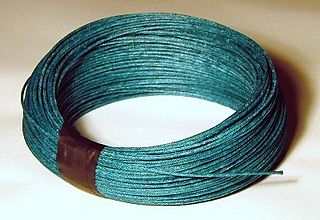
A visco fuse is a higher-quality fuse used for consumer fireworks. It is most commonly colored green, red, or pink and is found as a twisted, coated strand. It is also used to create delays in the firing of multiple firework displays for safety.

IllumiNations: Reflections of Earth was a nighttime show performed nightly at Epcot at the Walt Disney World Resort in Bay Lake, Florida. The show utilized fireworks, pyrotechnics, water fountains, fire effects, lasers, searchlights, and a large rotating globe with curved LED screens to create a visual production on the park's World Showcase Lagoon.
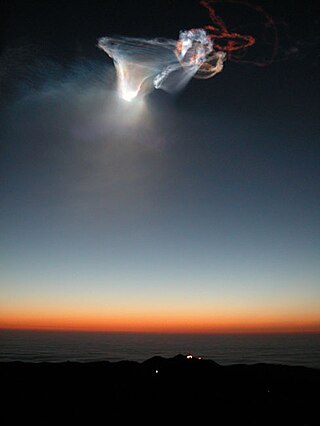
A twilight phenomenon is produced when exhaust particles from missile or rocket propellant left in the vapor trail of a launch vehicle condense, freeze, and then expand in the less dense upper atmosphere. The exhaust plume, which is suspended against a dark sky, is then illuminated by reflective high-altitude sunlight through dispersion, which produces a spectacular, colorful effect when seen at ground level.
A pyrotechnic composition is a substance or mixture of substances designed to produce an effect by heat, light, sound, gas/smoke or a combination of these, as a result of non-detonative self-sustaining exothermic chemical reactions. Pyrotechnic substances do not rely on oxygen from external sources to sustain the reaction.
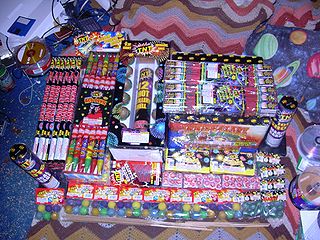
Consumer fireworks are fireworks sold for use by the general public. They are generally weaker in explosive power than the fireworks used in professional displays.

Fragmentation is the process by which the casing, shot, or other components of an anti-personnel weapon, bomb, barrel bomb, land mine, IED, artillery, mortar, tank gun, or autocannon shell, rocket, missile, grenade, etc. are dispersed and/or shattered by the detonation of the explosive filler.
Disney's Celebrate America is a seasonal fireworks show that premiered on July 3, 2008, at the Magic Kingdom theme park in the Walt Disney World outside Orlando, Florida, on July 4 of that same year at Disneyland in Anaheim, California, and on July 1, 2011, at Disney California Adventure in Anaheim, California. The 15-minute show, produced by Disney Live Entertainment under creative director Steve Davison, celebrates the traditions, spirit and music of the United States of America, and is shown in lieu of the regular fireworks shows on both July 3 and 4 at Walt Disney World's Magic Kingdom, Disneyland, and Disney California Adventure. While these parks use the same soundtrack, the fireworks used are different, due to Anaheim and Orlando's fireworks laws being more strict. This is the first time in history that Disneyland, Magic Kingdom, and Disney California Adventure share similar fireworks shows.
Magical: A Nighttime Spectacular of Magical Celebrations was a 2009–2014 summer fireworks show at Disneyland. Produced by Walt Disney Creative Entertainment, the show featured recorded music and dialogue, fireworks, lower level pyrotechnics, 10k spotlights, and gobo projections via Vari-Lite 3000 Spot fixtures housed in enclosures on Sleeping Beauty Castle and the Matterhorn. The show's main musical theme was an adapted rendition of the main theme from Tokyo Disneyland's It's Magical 10th Anniversary Castle Show and Epcot Center's Splashtacular. Magical was intended as a replacement for Remember... Dreams Come True and as a nighttime entertainment offering for Disneyland's Summer Nightastic promotion, but mainly for the 55th anniversary of Disneyland in 2010.
This glossary of astronomy is a list of definitions of terms and concepts relevant to astronomy and cosmology, their sub-disciplines, and related fields. Astronomy is concerned with the study of celestial objects and phenomena that originate outside the atmosphere of Earth. The field of astronomy features an extensive vocabulary and a significant amount of jargon.
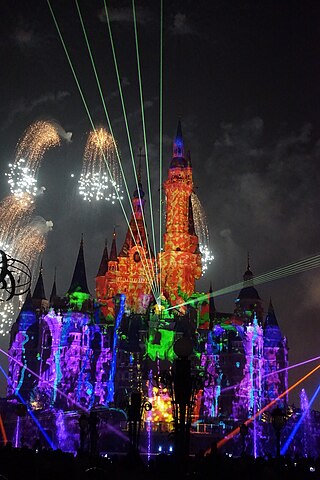
Ignite the Dream: A Nighttime Spectacular of Magic and Light was a nighttime spectacular at Shanghai Disneyland Park in the Shanghai Disney Resort. Ignite the Dream unfolds on the park's castle, Enchanted Storybook Castle, similar to other hybrid-nighttime castle shows found at other Disney parks, including: Disney Illuminations at Disneyland Paris for the 25th Anniversary edition. The show features fireworks, water fountains, fire, lasers, projection mapping, and searchlights. The show's story is centered on Mickey Mouse flying through the evening sky after discovering a magical spark that ignites his imagination.
















